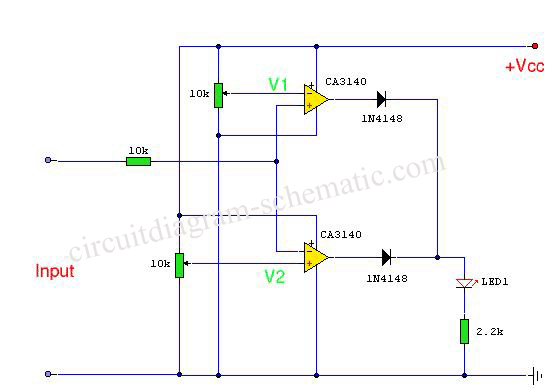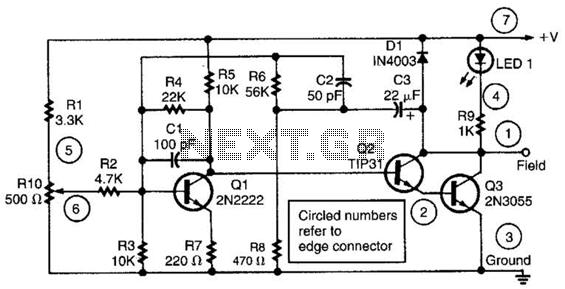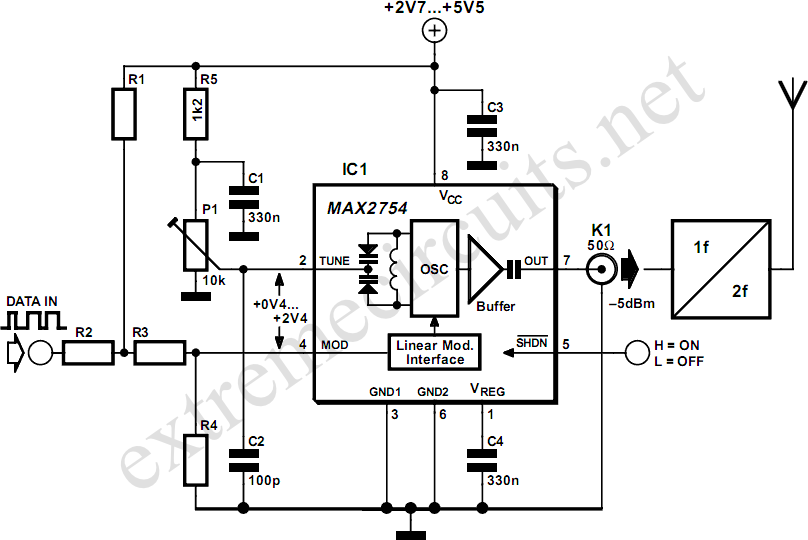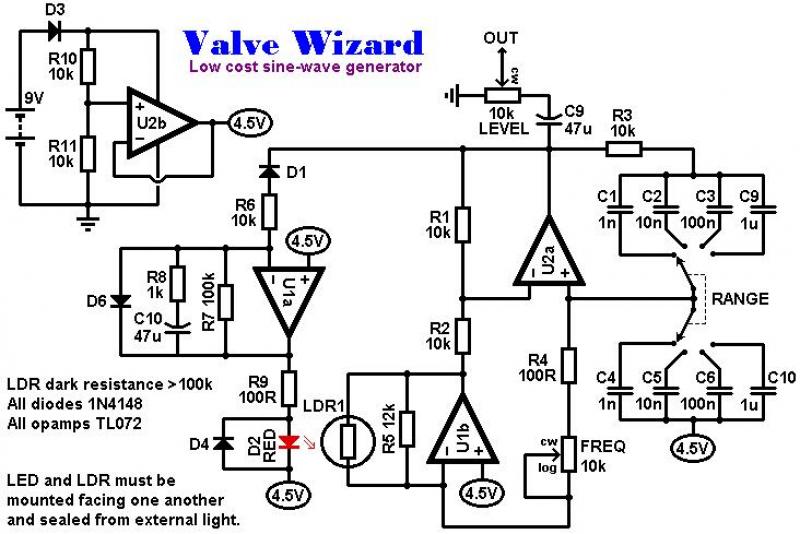
ultra low drop linear voltage regulator
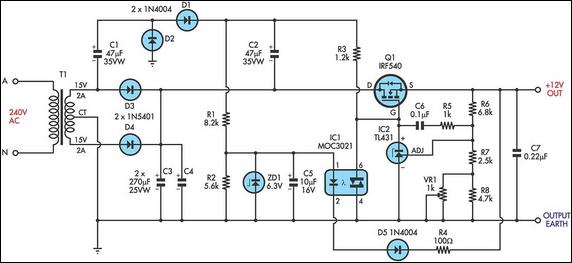
This circuit is a MOSFET-based linear voltage regulator with a voltage drop as low as 60mV at 1A. It utilizes a 15V-0-15V transformer and an IRF540 N-channel MOSFET (Q1) to deliver a regulated 12V output. The required gate drive voltage for the MOSFET is generated using a voltage doubler circuit comprising diodes D1 and D2, along with capacitors C1 and C2. To fully turn on the MOSFET, the gate terminal needs to be approximately 10V above the source terminal, which is connected to the DC output. The voltage doubler supplies this voltage to the gate through resistor R3. IC2, a TL431 adjustable shunt regulator, functions as the error amplifier, dynamically adjusting the gate voltage to maintain output regulation. With an adequate heatsink for the MOSFET, the circuit can provide up to 3A output with a slightly elevated minimum voltage drop. A trimpot (VR1) is included for fine adjustment of the output voltage. An RC network consisting of R5 and C6 provides compensation for the error amplifier. Additionally, the circuit features short-circuit crowbar protection to safeguard against accidental output shorts. Under normal operating conditions, the voltage across capacitor C5 will be 6.3V, keeping diode D5 reverse-biased by the output voltage of 12V. However, during a short-circuit condition, the output voltage will momentarily drop, causing D5 to conduct. This activates the MOC3021 triac optocoupler (IC1), which pulls the gate voltage to ground, limiting the output current. The circuit remains latched in this state until the input voltage is switched off to reset it.
The MOSFET-based linear voltage regulator circuit is designed for efficient voltage regulation with minimal voltage drop, making it suitable for applications where low dropout and high current capability are essential. The IRF540 N-channel MOSFET is selected for its high current handling and low on-resistance characteristics, which contribute to the overall efficiency of the design. The use of a 15V-0-15V transformer allows for a sufficient input voltage range, ensuring that the MOSFET operates within its optimal range while providing a stable 12V output.
The voltage doubler circuit, consisting of diodes D1 and D2 along with capacitors C1 and C2, effectively generates the required gate drive voltage. This configuration is critical for ensuring that the MOSFET is fully enhanced, allowing it to conduct with minimal resistance. The TL431 adjustable shunt regulator serves as a feedback mechanism, continuously monitoring the output voltage and adjusting the gate drive voltage accordingly to maintain the desired output level. The inclusion of a trimpot (VR1) allows for precise tuning of the output voltage, accommodating variations in load and input voltage.
The error amplifier compensation network, formed by resistor R5 and capacitor C6, stabilizes the feedback loop, preventing oscillations and ensuring smooth operation across various load conditions. The short-circuit protection mechanism is a vital safety feature, preventing damage to the circuit during fault conditions. The use of the MOC3021 triac optocoupler provides electrical isolation between the control and power sections of the circuit, enhancing reliability and safety.
Overall, this circuit exemplifies a robust design for a linear voltage regulator, combining high efficiency, precise voltage regulation, and essential protection features, making it ideal for various electronic applications requiring stable power supply.This circuit is a Mosfet-based linear voltage regulator with a voltage drop of as low as 60mV at 1A. The circuit uses a 15V-0-15V transformer and employs an IRF540 N-channel Mosfet (Q1) to deliver the regulated 12V output. The gate drive voltage required for the Mosfet is generated using a voltage doubler circuit consisting of diodes D1 & D2 and c
apacitors C1 & C2. To turn the Mosfet fully on, the gate terminal should be around 10V above the source terminal which is connected to the DC output. The voltage doubler feeds this voltage to the gate via resistor R3. IC2, a TL431 adjustable shunt regulator, is used as the error amplifier. It dynamically adjusts the gate voltage to maintain the regulation at the output. With an adequate heatsink for the Mosfet, the circuit can provide up to 3A output at slightly elevated minimum voltage drop.
Trimpot VR1 is used for fine adjustment of the output voltage. The RC network consisting of R5 and C6 provides error-amplifier compensation. The circuit is provided with short-circuit crowbar protection to guard against an accidental short at the output. This crowbar protection works as follows: under normal working conditions, the voltage across capacitor C5 will be 6.
3V and diode D5 will be reverse-biased by the output voltage of 12V. However, during output short-circuit conditions, the output will momentarily drop, causing D5 to conduct. This triggers the MOC3021 Triac optocoupler (IC1) which in turn pulls the gate voltage to ground. This limits the output current. The circuit will remain latched in this state and the input voltage has to be switched off to reset the circuit.
🔗 External reference
The MOSFET-based linear voltage regulator circuit is designed for efficient voltage regulation with minimal voltage drop, making it suitable for applications where low dropout and high current capability are essential. The IRF540 N-channel MOSFET is selected for its high current handling and low on-resistance characteristics, which contribute to the overall efficiency of the design. The use of a 15V-0-15V transformer allows for a sufficient input voltage range, ensuring that the MOSFET operates within its optimal range while providing a stable 12V output.
The voltage doubler circuit, consisting of diodes D1 and D2 along with capacitors C1 and C2, effectively generates the required gate drive voltage. This configuration is critical for ensuring that the MOSFET is fully enhanced, allowing it to conduct with minimal resistance. The TL431 adjustable shunt regulator serves as a feedback mechanism, continuously monitoring the output voltage and adjusting the gate drive voltage accordingly to maintain the desired output level. The inclusion of a trimpot (VR1) allows for precise tuning of the output voltage, accommodating variations in load and input voltage.
The error amplifier compensation network, formed by resistor R5 and capacitor C6, stabilizes the feedback loop, preventing oscillations and ensuring smooth operation across various load conditions. The short-circuit protection mechanism is a vital safety feature, preventing damage to the circuit during fault conditions. The use of the MOC3021 triac optocoupler provides electrical isolation between the control and power sections of the circuit, enhancing reliability and safety.
Overall, this circuit exemplifies a robust design for a linear voltage regulator, combining high efficiency, precise voltage regulation, and essential protection features, making it ideal for various electronic applications requiring stable power supply.This circuit is a Mosfet-based linear voltage regulator with a voltage drop of as low as 60mV at 1A. The circuit uses a 15V-0-15V transformer and employs an IRF540 N-channel Mosfet (Q1) to deliver the regulated 12V output. The gate drive voltage required for the Mosfet is generated using a voltage doubler circuit consisting of diodes D1 & D2 and c
apacitors C1 & C2. To turn the Mosfet fully on, the gate terminal should be around 10V above the source terminal which is connected to the DC output. The voltage doubler feeds this voltage to the gate via resistor R3. IC2, a TL431 adjustable shunt regulator, is used as the error amplifier. It dynamically adjusts the gate voltage to maintain the regulation at the output. With an adequate heatsink for the Mosfet, the circuit can provide up to 3A output at slightly elevated minimum voltage drop.
Trimpot VR1 is used for fine adjustment of the output voltage. The RC network consisting of R5 and C6 provides error-amplifier compensation. The circuit is provided with short-circuit crowbar protection to guard against an accidental short at the output. This crowbar protection works as follows: under normal working conditions, the voltage across capacitor C5 will be 6.
3V and diode D5 will be reverse-biased by the output voltage of 12V. However, during output short-circuit conditions, the output will momentarily drop, causing D5 to conduct. This triggers the MOC3021 Triac optocoupler (IC1) which in turn pulls the gate voltage to ground. This limits the output current. The circuit will remain latched in this state and the input voltage has to be switched off to reset the circuit.
🔗 External reference
